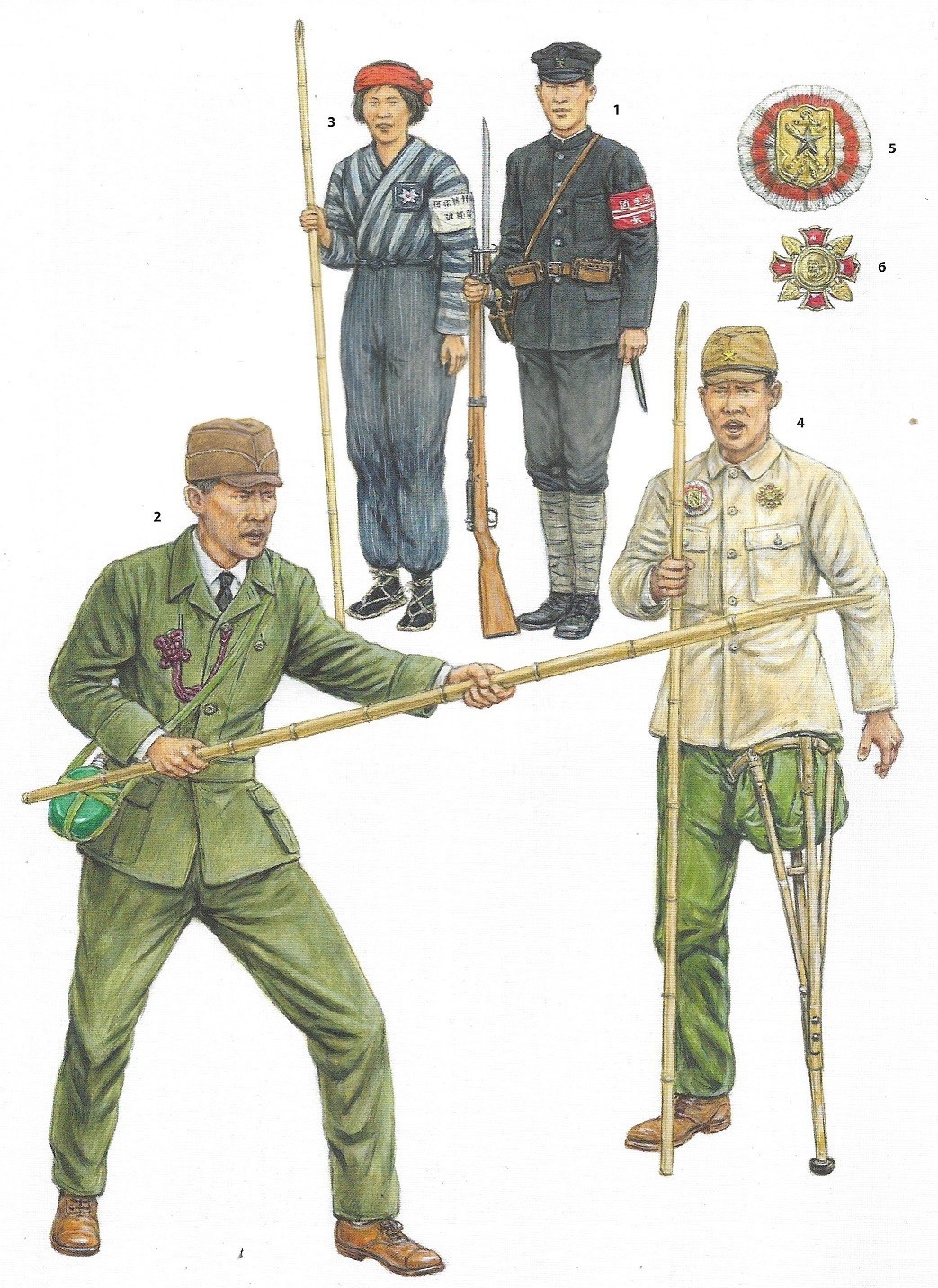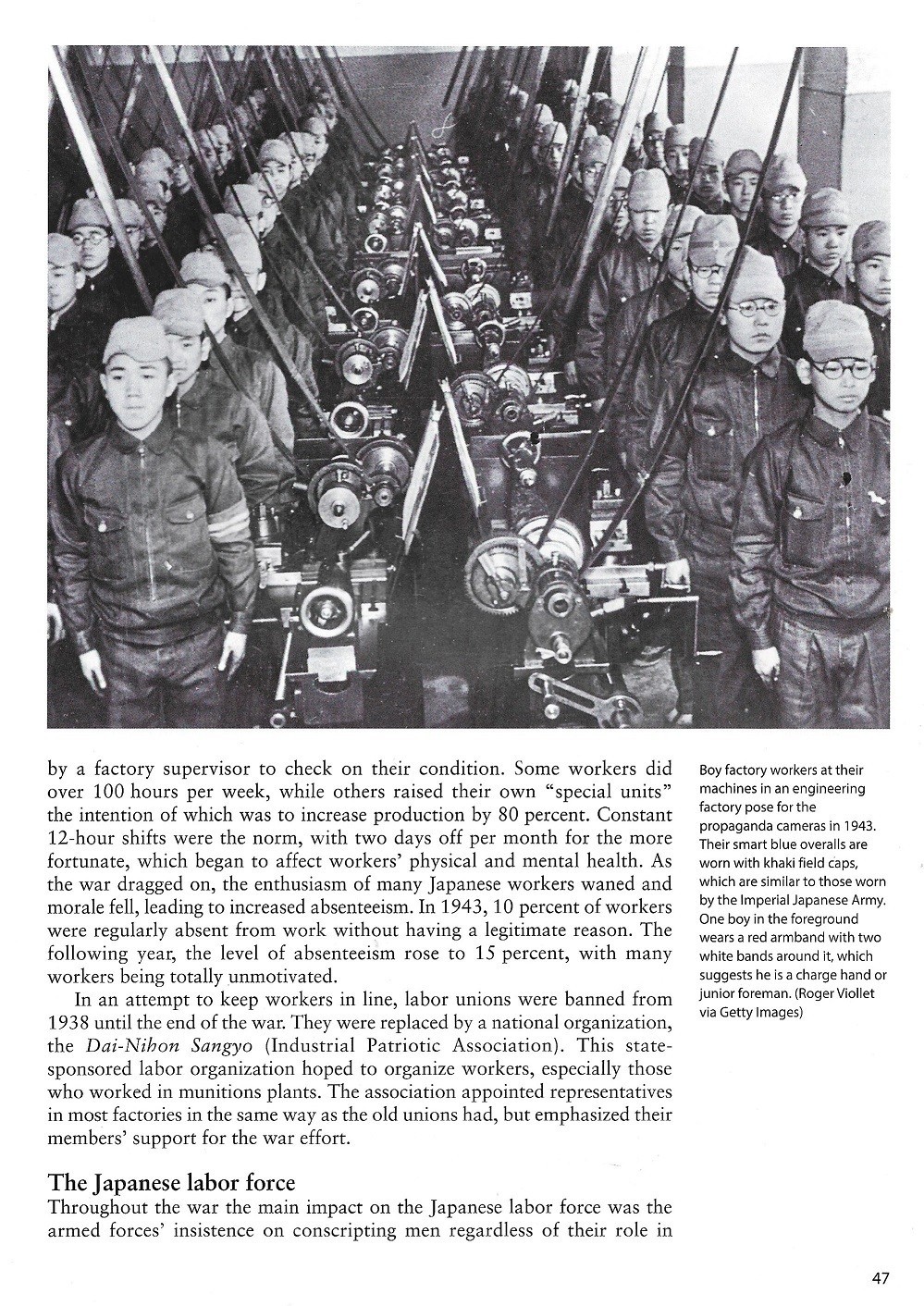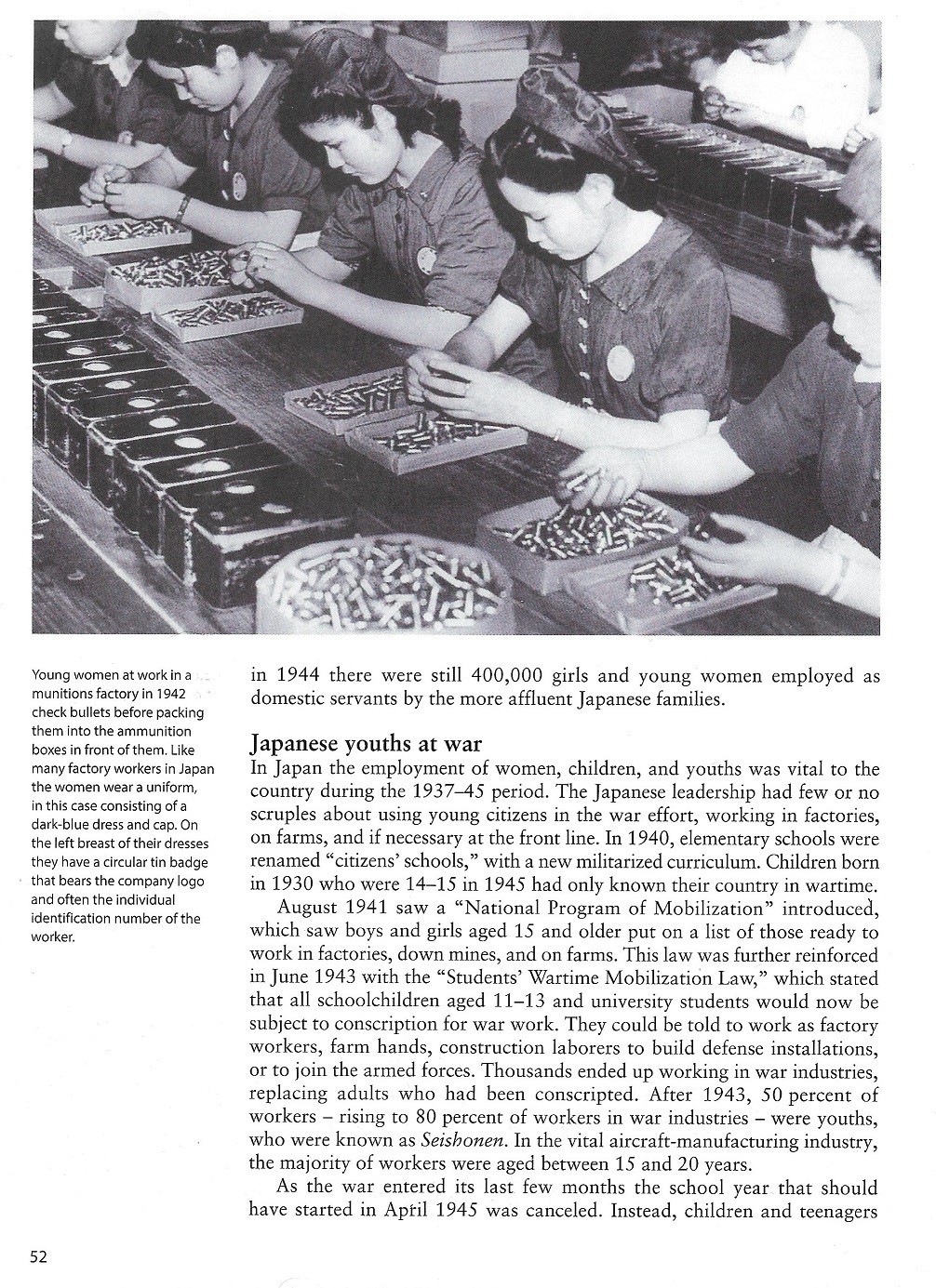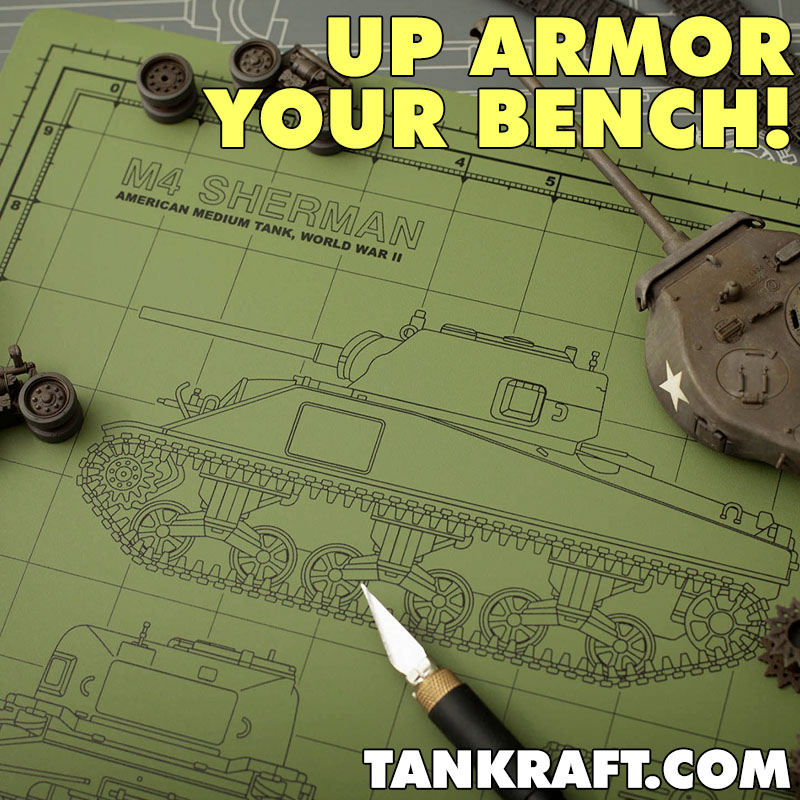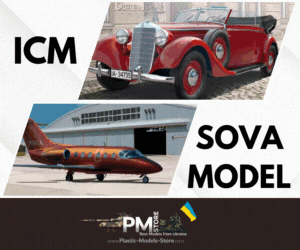HISTORY:
** From the beginning of the Second Sino-Japanese War in 1937 until the Japanese surrender in August 1945, a multitude of military and civil-defense forces strove to support the Japanese war effort and latterly prepared to defend the home islands against invasion. During World War II, Japan was the world’s most militarized society and by 1945 nearly every Japanese male over the age of 10 wore some kind of military attire, as did the majority of women and girls. In this volume, Phillip Jowett reveals the many military and civil-defense organizations active in wartime Japan, while specially commissioned artwork and carefully chosen archive photographs depict the appearance of the men, women, and children involved in the Japanese war effort in the home islands throughout World War II. **
** Quoted from the back cover of the book.
THE BOOK:
Osprey Publications has released The Japanese Home Front 1937–45 as Number 240 in their Elite series. It is a soft cover book with 64 pages. Included with the text are black and white photographs, color illustrations, detailed captions and more. It has a 2021 copyright, a publication date of August 19, 2021 and the ISBN is 978-1-4728-4553-5.
THE CONTENTS:
- Introduction
- Medical Services
- The Japanese Red Cross
- Emergency medical services, 1944-45
- The Police
- The Kempeitai
- The Tokubetsu Kōtō Keisatsu
- The Keibitai
- The Fire Service
- Private fire brigades
- The neighborhood associations’ role in firefighting
- The Keibodan
- Civil-Defense Organizations
- Neighborhood associations
- Women’s patriotic associations
- Patriotic Volunteer Groups
- Civilian volunteers
- Patriotic youth groups
- The Boetai
- Air Defenses
- The evacuation of civilians, 1944-45
- The Transportation System
- The railroad system
- Motor transport
- Merchant shipping
- Industries In Wartime
- The Japanese labor force
- Women in the war industries
- Japanese youths at war
- Feeding the nation
- Daily Life In Wartime Japan
- Restrictions on daily life
- The rationing of goods and services
- Food shortages
- Public health
- The effects of US bombing on Japan
- Bibliography
- Index
THE TEXT:
Author Philip Jowett provides a well written text detailing the Japanese home front during World War II. The text goes into great detail in all areas of the book as outlined on the contents page, please refer to the contents listing for the areas that are covered through the book. The subjects listed are well discussed down to the smallest detail. Philip Jowett has provided a wealth of information describing several aspects of the lives, roles and expectations of the Japanese population regarding their country’s war effort. Some of the subjects detailed are the age of military conscription and how it changed during the course of the war, the importance and responsibilities of firefighting departments and the issues within due to lack of properly trained personnel and proper equipment, police departments and their roles, medical services, manufacturing and farming responsibilities, civilian organizations, women filling traditional men’s roles due to staffing shortages created due to military conscription, roles of children in the war effort and equipment shortages and weapon shortages which led to many civilian home defense groups being armed with, and conducting military drill with, bamboo spears. An area discussed that I found particularly interesting is how the Japanese government created problems when they conscripted able bodied men from critical manufacturing jobs which in turn created supply and manufacturing issues which resulted in a shortage of crucial military equipment. A good portion of the text is dedicated to the types of clothing and uniforms worn by the civilian population. Details of the clothing include the types of materials they were made of, the purpose of the clothing items, insignia, patches and pins and badges worn and the importance of them, how material and clothing shortages led to changes in fashion trends, and other such information. As I read through the text, I didn’t notice any spelling errors, but I did find a couple of grammatical errors. However, they are minor and take nothing away from the book. Grammar and spelling might not be an important factor to everyone however it is something that I take notice of and pass on my findings. I feel that if the text is well written then it shows that the author has taken the time to be professional with their writing. Anyone wanting to add an excellent reference and history book on the Japanese home front during the years of 1937 through 1945 to their personal library will be pleased with this informative book.
THE PHOTOGRAPHS:
A total of 48 black and white photographs and 9 color photographs are included in this volume. The accompanying photographs contained in the book definitely help give the reader a visual reference for the text that they are reading. The majority of the photographs are staged and were used for propaganda purposes. The photographs range from wide angle photographs to close-up detailed photographs. The majority of the photographs are clear and easily viewable; however, a few have an out of focus look to them and some appear to be too dark, and others appear too light. This is typical for the discussed periods of history and consideration needs to be given to the fact that most of the photographs are over seventy-five years old and the quality of the photographs is of no fault of the author and do not take anything away from the book. Author Philip Jowett stuck to the title of the book and chose subject specific photographs and did not include photographs that strayed from the main subject of the book. The majority, if not all, of the photographs will prove to be a wealth of information to the scale figure modeler and to anyone interested the uniforms, weapons and equipment used on the Japanese home front during the years of 1937 through 1945 due to the details they contain.
THE ILLUSTRATIONS:
There are 8 pages of color illustrations included in the volume containing a total of 39 illustrations by illustrator Adam Hook. Each color illustration is accompanied by a detailed caption. The illustrations are very well done, nicely detailed and are of:
Plate A
Police Personnel
Plate B
Firefighting Personnel, 1944-45
Plate C
Keibodan Personnel
Plate D
Early Home-Front Volunteers, 1937
Plate E
Civilians Undergoing Military Training, 1943-45
Plate F
Youth Volunteers
Plate G
Air-Defense Personnel, 1944-45
Plate H
Industrial Volunteers
THE CAPTIONS:
The captions are well written and explain the accompanying photographs and illustrations in great detail eliminating any doubt as to what is shown. The captions go into very specific detail as to specific roles of the individuals shown, types of military and non-military uniforms and the material they are made from, uniform accruements, equipment and tools being used, weapon types, dates, locations and other such pertinent information. As I read through the captions, I didn’t notice any spelling errors but I did find two grammatical errors in the captions. The caption on page 30 states “If the 1945-1946 Allied invasion of Japanese” had taken place”. It should state “Japan’, not “Japanese”. And on page 59, the first sentence in the caption states “and conducting drill with their bamboo spears”. It should state “in conducting drill”. Other than the two errors I found I was impressed by Philip Jowett’s captions as they are very helpful to the reader due to their detailed content as opposed to other captions that I have seen that are very brief and lacking in detail.
Osprey Publishing also offers The Japanese Home Front 1937–45as:
eBook (ePub) ISBN: 978-1-4728-4554-2
and
eBook (PDF) ISBN: 978-1-4728-4551-1
Osprey Publishing’s, The Japanese Home Front 1937–45 is also available as a Kindle version through Amazon.com
PRICE:
UK £12.99 / US $20.00 / CAN $26.99
This book was provided to me by Osprey Publishing. Please be sure to mention that you saw the book reviewed here on the KitMaker Network when you make your purchase. Thank you.



